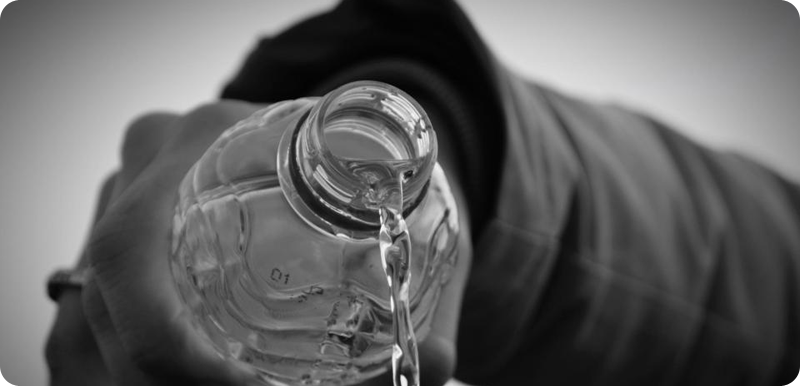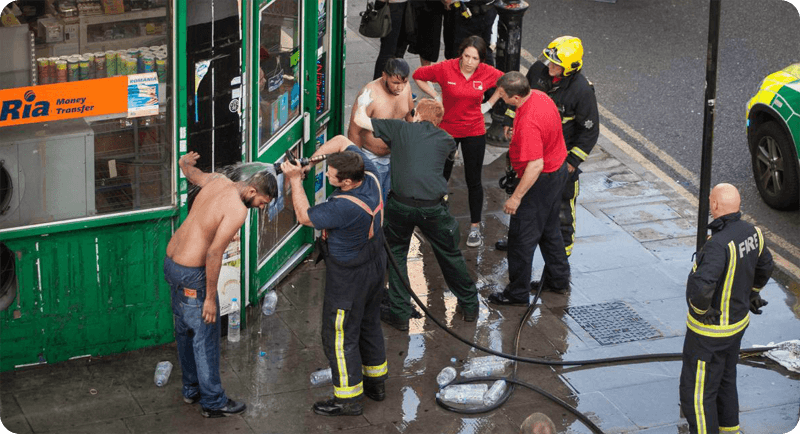Acid Attack First Aid: What you need to do – An acid attack maims a victim with corrosive fluid and can scar them for life, inflicting serious injuries and potentially leaving victims blind. If you are the victim of an acid attack or witness one taking place, it’s important to act as quickly as possible to minimise damage to the eyes, skin and surrounding tissues.

The number of acid attacks in the capital have increased from 261 in 2015 to 458 last year.
As the threat persists, it is important to know the first aid dos and DON’Ts, if you find yourself aiding a victim.
Q: What do I do in an acid attack?
A: If you are unlucky enough to witness a corrosive attack, urgent action can considerably reduce the severity of the injury, prevent blindness and scarring. The NHS gives advice to ‘Report, Remove and Rinse’.
Here is important guidance on how to help:
REPORT – call 999, but ask for the Fire Service too!
When calling 999 you might only think about asking for the Police and Ambulance, but ask for the Fire Service too if you don’t have LOTS of running water to hand. The Fire Service often arrive first and they are equipped to deal with burns of all types.
Stay safe! Remember, rule number one is look after yourself!
- Stay well clear of any attacker – run if you have to, don’t get involved in any argument.
- Protect yourself – make sure you don’t come into contact with the chemical. Ask the casualty to remove their own clothing so you don’t get contaminated too. If you don’t have protective gloves, placing plastic bags over your hands might help prevent contact.
- Make sure the area is well ventilated. Open windows and doors or move outside if possible.
REMOVE – contaminated clothing

ALL contaminated clothing needs removing urgently:
- Use scissors to cut away clothing if you can.
- Ideally, ask the casualty to remove their own clothing (while trying to avoid touching the areas that are contaminated). If there are two casualties they can help each other.
- If you have to pull clothing over the head – pull the back of the sweater/t-shirt over the head to avoid contaminating the face.
- Pile contaminated clothes in a safe place or in a bin. Inform police where they are for forensic analysis.
- Dry/powder chemicals on the skin should be brushed off before rinsing with water. Use clean clothes or paper towels to do this. Lightly brush – don’t rub or wipe.
RINSE – continuously with water
As soon as possible rinse the affected area continuously with clean water to wash the chemical off. The longer it takes to do this, the deeper the burns will go, so make every effort to find a water supply quickly!
- Ideally, use clean running water, but using whatever water you have is probably better than delaying treatment to find a perfect water supply. You might be able to start treatment now and then move the casualty when a better water supply is found.
- Irrigating the face and eyes should take priority.
- Try not to spread the chemical as you wash it off – get the contaminated part of the body as low as possible so water runs away from the unaffected parts and doesn’t pool on the skin. Avoid contamination from one eye to the other.
- DO NOT try to ‘wipe’ the chemical off because this might rub it in or spread it.
- Carefully remove jewellery at this stage – chemicals can get underneath jewellery and rings need removing before fingers swell up.
- Using lukewarm water (rather than cold water) helps to avoid hypothermia, but using cold water is much better than none.
- If you use a fire hose or garden hose keep the pressure low, so you don’t drive the chemical deeper or splash it on everyone.
- Irrigation with water needs to continue for an absolute minimum of 20 minutes. Make a note of the time you started – this information is useful for the emergency services.
Corrosives in Eyes:
The eyes are extremely vulnerable and corrosives can cause blindness, so careful irrigation of the eyes is a high priority:
If only one eye is affected, make sure water runs away from the good eye.
Irrigate the eyes both inside and out. If needed, wear protective gloves, and then gently but firmly open the eyelid(s) to irrigate the eye(s) fully.
Irrigate the eyes like this for at least 20 minutes. This may not be easy, but blindness is much worse!
Ideally contact lenses need to be removed. The safest way to do this is to flush them out with water. NEVER try to forcibly remove a contact lens and NEVER try to take one out with contaminated fingers!
Our first aid training including the 1 Day Emergency First Aid at Work and 3 Day First Aid at Work courses cover injuries due to an acid attack.
